For previous chapter click here
The Obstacles of Privilege
Tanzania 2021
Despite periods of deep enjoyment, my coverage of the Serengeti turned out to be an increasingly difficult time in my life. Burnout doesn’t just go away. You can’t work yourself through it, as that kind of has the opposite effect, not surprisingly. I was, as always, on the road, living out of a bag in a different hotel every other night and going through a protracted divorce. I barely saw my children for a year, which left me absolutely wracked with guilt, and I couldn’t explain to them why I’d left, choosing to remain silent, so I shouldered not only everyone else’s scorn but theirs too. I’d also fallen completely and madly in love, in a way so deep and intense that it was ultimately toxic.
I fell in love with Maria the moment I clapped eyes on her walking through the door of a wine bar in DC. She was, simply, the most beautiful woman I’d ever seen. My love for her was immeasurable– a deep, all-consuming, intense love that we both felt. Before we’d even kissed, she flew out to Tanzania and I met her off the plane at Kilimanjaro airport, handed her an iced G&T in the Land Rover and we barely left each other’s side for the next year and a half. Our first date was a trip through the Ngorongoro Crater and the Serengeti, sleeping in a roof tent on top of the Land Rover, drinking G&T and listening to Radiohead as we drove along bumpy tracks.
Maria was Colombian, as fiery as they come, fiercely independent, self-assured and strong to the point of being terrifying. She spoke her mind without filter and impressed me with an understanding of the world completely different to my own. She’d travelled extensively across the world, working as a photojournalist covering issues of displacement, sexual violence and conflict, and she wore it, just as she wore the obvious trauma of a life growing up in the midst of Colombia’s troubles.
What made her so desirable in my eyes also made her incredibly difficult. Maria and I loved each other madly but we argued constantly, and the intensity of our life on the road, the pressure on me to shoot an entire magazine issue in a place where even the simplest transaction can become a long, drawn-out experience soon turned into an endless turmoil and I quickly began to unravel.
I put enormous pressure on myself when I have a story to shoot. It’s a requisite part of my job. I have to constantly create high-quality images and I don’t think I’m a very good photographer; so the most wonderful assignment, the dream assignment like shooting the Serengeti, can often collapse into becoming a study of failure and loss of self-esteem.
Depression started to creep up on me, compounded by the endless weeks of sitting in the cars waiting for something to happen, for some shot to jump out of nowhere. I felt as if I were on a losing streak, blowing thousands of dollars a day and getting nothing – no epic shot, no quirk, no nothing. What I needed was quiet and kind encouragement, what I got was Maria – always there to tell me exactly what she thought and all the things I was doing wrong.
I’d deflect my own woes, ‘the obstacles of privilege’ as I’d joke in my moments of failure and self-indulgent wallowing. I’d try and offset my problems with the reality of the continent I was on – but like telling a kid to eat their peas because of all the starving children in the world, it just didn’t work. It’s idealistic to think that we can offset our own negative thoughts and experiences by comparing them with those we see as less fortunate than us – but it’s also unrealistic. And besides all this, the poverty of others should never be a crutch to help us get to our feet.
Wildlife photography is a lesson in being out of control. It can be incredibly frustrating, and when you already have too much on your shoulders you desperately crave resolution and success. The only way to counter this lack of control is time spent in the field, as that’s ultimately the only way you can control what you’re doing – knowing that if you’re there long enough, you’ll get what you need in the end. The problem is when you’re burning money doing precisely this, and still failing – every day of failure loads more and more onto your shoulders, until all the years of dealing with your lack of control eventually become too much.
And so my mood worsened, my patience turning to irritation and frustration. Exciting moments shooting pictures were now tainted by destructive and bitter self-criticism, focusing on what I’d failed to shoot rather than what I’d succeeded in capturing. The disparity between what I convinced myself I had to get and what I was actually getting grew ever wider. My sleep pattern collapsed as I’d lie awake at night, stressed, worrying, my chest tight with heartburn, and I’d spend my days exhausted, constantly yawning. True burnout is a harbinger of despair. I didn’t know it then, but Serengeti foreshadowed a year of depression.
The Serengeti ecosystem is vast. Formed by volcanoes spewing out billions of tonnes of ash, drowning hills and mountains millennia ago, it now supports perhaps the most impressive aggregation of animals on the planet. Its ancient past is still visible on its south-eastern edge, bordered by the sharp, free-standing peak of Ol Doinyo Lengai, an active volcano considered sacred by the Maasai. To hop in a Cessna and fly west from Lengai you drift over green hills and plains dotted with extinct volcanoes and craters. Some are small and perfectly coned, others large and ragged like Empakaai, a deep crater cloaked by forest with a lake in the middle and an air of Conan Doyle’s Lost World about it.
West of Empakaai lies the vast Ngorongoro Crater – seven miles across, this is perhaps the world’s greatest wildlife destination, its lush, flat plains and expansive lake walled in by giant craterous walls. Home to lions, elephants, rhinos and buffalo, and most of the other species on the East African bucket list, the crater’s steep and forested perimeter cuts it off from the migrations that extend across much of the Serengeti. As a result the animals within generally remain resident on the crater floor all year round.
Head north from the crater and you pass over Maasai communities – dotted houses and ringed bomas, cartoon cute from the air. Red figures chase cattle herds heading out to graze or find water along tracks long worn in the earth. Rolling green hills appear, casting long shadows across the vast flat expanse of Angata Kiti, spotted with myriad grazers: zebras, hartebeest, elan, topi and the darker forms of wildebeest. Far off on the horizon the rocky landscape of the Gol Kopjes wobbles in the heat haze – once extensive hills and mountains, this area too was drowned by volcanic ash and is now a series of isolated and rounded outcrops rising out of the grasslands. Lions and cheetahs live among the Kopjes, stetched out in the sun on the vast boulders like a scene from The Lion King. A few minutes west and the short grass plains of Ndutu unravel.
This, for me, is the Serengeti, a seemingly limitless and empty expanse of grassland stretching as far as the eye can see. Flat, lifeless for much of the year, scarred by the occasional road, but essentially featureless for mile upon mile. These plains come to life in the early spring with the seasonal rains as the migration swells across them, their nutrient-rich grasses essential for the calving wildebeest. I’ve stood on Naabi Hill, the only break in the great plain, and panned my camera for a minute and a half over a single herd perhaps a million strong – 180 degrees of wildebeest stacked in tight and stretching off to infinity, a sight simply incomparable in the natural world.
To the north the flat grasslands are replaced by woods and hills that continue all the way to the Mara River, the only water source flowing all year, beyond which lie the Kenyan border and the Maasai Mara. Its mix of uplands, woodlands, riverine forests, acacia savannah and rolling grass plains make the Mara a wildlife heaven. Whereas the Serengeti’s wildlife ebbs and flows with the continuous clockwork rotation of the great migration, the Mara is always teeming with life. It’s small compared with the Serengeti National Park and increasingly constricted on its western, northern and eastern flanks by wheat farms, unmanaged fencing, gazetting and Maasai cattle interests. But it remains clear to the south as it borders the Serengeti.
In July, seasonal rains drive the wildebeest to the northern Serengeti and across the border into Kenya. Here they’re forced to cross the Mara River, sometimes multiple times as they seek out fresh pasture. The river crossings are the single most dangerous obstacle the wildebeest face, and they become incredibly animated and nervous in anticipation of them. Being ambushed by leopards and lions on the river’s bushy edge and pulled under by enormous crocodiles as they attempt to swim the river are their most obvious fears, but drowning is their greatest threat. My job for the Serengeti issue, above all else, was to cover the river crossings.
The traditional crossing spots are usually named by locals and safari guides after their location or their aspect: ‘Main crossing’ – a shallow rapid bordered by low banks and open plains; the ‘U crossing’ – a sharp bend in the river below Lookout Hill, with steep but accessible banks; the ‘Cul-de-sac’ – easy on the way in but bottlenecks on the way out, causing chaos and death from exhaustion and drowning. Then there’s ‘Chinese crossing’, ‘Paradise crossing’, ‘Serena crossing’, ‘Kichwa crossing’ and many others.
Wildebeest are extraordinarily good at killing themselves. They don’t need much encouragement, and in fact worry so much about dying as they cross the river that they panic, stampede and kill each other. Three and a half thousand drowned in one crossing event back in 2013 when I was filming in the Mara; the previous day ten thousand had died trying to cross. These are small numbers that barely dent the population of 1.4 million animals that make the annual migration, but they’re still both impressive and horrific.
High season for tourists in the Mara are the summer months. The migration swells across the plains and all the predators that have struggled in the lean months suddenly find themselves confronted by a glut of food. It makes the game drives dramatic and exciting, but it’s the crossings that all the tourists really want to see. These are hard to predict, though, and are usually swamped with cars when they take place. I’d burdened myself with the impossible task of capturing the ultimate image of a crossing, one that would stand above the tens of millions of images taken over the last few decades. I really had no choice in the matter, if National Geographic was covering the crossings.
To photograph them you’ve basically got to do nothing but sit and wait, sometimes for days, sometimes for weeks. Perched on a hillside above the river, you find a spot that affords the greatest vista and you keep your eyes open. It’s stiflingly hot and mind-numbingly boring. I’d watch whatever I’d downloaded onto my iPad – Eastbound & Down, Peaky Blinders, Game of Thrones – and then watch it all over again. Every ten minutes I’d lift my binoculars up for a scan, checking to see if the wildebeest had lost interest in grazing and begun to gather into lines, heading towards the river.
The process is usually protracted, as idle, slow-motion chaos gently finds order and a line is formed. Who decides they’re going to cross, who leads – these remain a mystery, but eventually the urge for fresh pasture becomes impossible to resist and the animals head off. But whether they actually cross or not is another matter. Sometimes the line breaks into a galloping herd with single-minded intent, swelling with excitement as they arrive at the river, only to stop suddenly, held hostage by their nerves, and stare at the opposite bank for hours before they eventually turn back to the plain to graze again. At other times they cross straight away, led perhaps by a bold individual who’s either cleverer or more stupid than the others, it’s hard to tell which.
The first year of Covid wrecked international tourism in Kenya. On weekdays the plains were the emptiest I’d ever seen them, but despite the obvious problems that this wrought on the Kenyan economy, it was also a true privilege to experience – the Mara quiet, the animals unmolested by tourists. Conversely, at the weekend the place was the busiest I’d ever witnessed, as Kenyans, taking advantage of cheaper lodge prices, flocked out of Nairobi to the Mara to see their native wildlife.
Weeks of failure to shoot a crossing had naturally left me stressed. Realising that the missing ingredient might be tourists, I lived in hope for a crossing on a weekend. As with the cheetahs, the crossings are a massive shitshow of cars, a spectacle I’d never yet seen covered. One Saturday, while parked high above the plains on the top of Lookout Hill, we noticed two large groups of wildebeest massing across the river in the Mara Conservancy. With reinforcements continually funnelling in from the hills to the west in enormous single-file lines, some miles long, the herds were growing rapidly. Although we were desperate to get down close to them, we were wise enough to know not to, so we just bided our time and watched patiently. Eventually, anticipating where they’d most probably cross, we drove the mile or so down the hill to the river.
We stopped a couple of hundred yards short of the edge, along with a few other cars who’d made the same calculation. Then we waited. After a while the wildebeest appeared in the dense croton thicket on the opposite bank, their numbers forcing them right to the edge. We could tell from the growing and incessant mooing that the herd was swelling ever larger behind the thicket, even though we couldn’t see them. For the next two hours the herd just grew and grew, but remained on the bank.
At the same time, a large number of cars had begun to mass on our side of the river. Safari drivers are all in constant radio and phone contact, alerting each other to any significant sighting. This had pulled in a steady mass of Land Cruisers and pick-ups, as well as numerous minivans and city cars that were completely unsuited to the slippery, rough terrain. As the vehicles began to accumulate across the plain towards the river, we reversed back up the hill to watch and count them. They snuck and jostled for position in front of each other, everyone creeping towards the river’s edge, wanting to be there when the animals crossed but not too soon lest they be spooked back into the plain behind them. As many of the cars were driven by tourists from town, they were unfamiliar with the etiquette and would just drive straight to the edge, until they retreated after having been sufficiently berated by the safari drivers, most of whom knew better.
The wildebeest eventually massed to a critical point, with those on the edge left with nowhere to go but down to the river. It took just a single animal to nervously descend one of the gorged cuts in the high bank, slipping and sliding through the dry sand steeply to the river’s gravel edge, before a torrent of animals suddenly flooded down the bank, like a dam finally breaking. Engines fired up on cue, and the moment the first animal struck a hoof into the water, 160 vehicles dropped like a demolished skyscraper down the hill to the edge of the river. It was extraordinary to watch the two great masses – one flesh, the other metal – move towards each other. By the time the first wildebeest reached the opposite bank the whole herd had erupted into a deafeningly loud mooing and were pouring themselves down and over the bank, their lines collapsing into chaos. Some animals followed the steep paths down, others simply leapt the sheer twenty-foot-high banks, crumpling into the mud below, where they’d either untangle themselves and struggle to their feet or lie there groaning in agony, their gangly legs pathetically twisted and broken beneath them.
As the line swimming and leaping across the river expanded from a single file to several animals wide, the crocodiles moved in, their sinister elongated heads pushing through the strong current with effortless speed. When they reached the wildebeest, the line would bend away from them, but as the hapless creatures kept swimming, now deranged into a frantic panic by the chaos, the crocodiles would pick off them with ease, laying their massive jaws across their victims’ necks or grabbing a leg and dragging them, whinnying and mooing as they gurgled their last breaths, off into the muddy depths.
When the wildebeest finally reached the opposite bank, they followed each other up narrow tracks cut through the steep bank, emerging out of the bushy edges into a wall of cars and people and shouting and cameras and chaos. This threw them into an even greater panic, scattering them between the vehicles, all calling frantically to each other, desperate to regroup, which they eventually did once they’d passed through this final and novel barrier.
We drove into the thick of the chaos chasing a frame, settling eventually behind a wall of cars that had been forced back by the rangers to create a corridor for the wildebeest to escape through as they exited the river. I hunted for images, changing lenses, changing cameras, looking for composition, micro-adjusting the cars position. I knew this was my moment and I simply couldn’t afford to fuck it up. Eventually Maria, eyes peeled as always for connection, saw the shot. A Kenyan couple in the car in front were wrapped around each other, lovingly aligning a selfie, with the wildebeest behind them. I quickly snapped three frames before they broke their pose.
It was a lovely shot, the horror of the scene tempered by a moment of emotional connection between two very happy people. It took the edge off the rawness, yet it still showed the chaos – the wildebeest running panicked in both directions in the background, the cars piled up along the riverbank and sprawled across the plain, almost all the way to the back of the frame. It was ugly and beautiful but ultimately it was the truth, and that’s all I wanted.
By early September Maria and I had reached an impasse. Every conversation led to an argument, every comment was taken the wrong way, every suggestion seemed a criticism. We blamed each other for the breakdown. In the end she flew to the coast for an assignment and left me wallowing in my own failure. The images I had were OK, and the shot with the selfie couple would make the magazine. But a lifetime of dreaming of shooting the best crossing picture ever, and the pressure on me to achieve this for the magazine had taken its toll. So I sulked in my car for the final week and not a single animal crossed the river.
Eventually I phoned my editor Kathy, as I always do when I need wisdom or an arse-kicking. I told her I’d made some nice frames but nothing extraordinary.
‘Have you got the shot?’
‘I’ve got some alright stuff.’
‘But have you got the defining shot of the crossing?’
‘Nope.’
‘Well then, you need to stay there until you have.’
I explained that the wildebeest had stopped crossing, that most had headed off south to Tanzania and that the whole thing was essentially over. I told her I was tired and broken and needed some time off – by that point I’d been on assignment for three months solidly, working sixteen hours a day without a break. She insisted that I do just one more week, and I eventually agreed.
I sat in my car and watched that river for a week, but nothing happened. By the last afternoon I’d become resigned to my own failure, trying to be philosophical and think about all the positives. It didn’t work, of course. It’s hard trying to explain obsession to people who don’t experience it, but back then I was obsessive to a destructive level, to a mental-health and relationship-destroying level – and I’d just failed.
At five o’clock on that final evening a small group of wildebeest appeared on the opposite bank. They’d run down from the north and were heading towards the ‘U Crossing’. A pile of cars had clocked them and they soon arrived, along with me, on the road above the crossing in anticipation. The excitement of the herd eventually waned however and after half an hour it collapsed altogether as the animals that had been heading towards the river lost momentum and headed back to the plains to graze.
Realising the chances of a crossing were dead, the thirty or so cars that had appeared all began heading back to their respective lodges for sunset. Eventually the only two cars left at the crossing were mine and my buddy, cameraman Warren Samuels. Warren sat a few hundred yards from me, hoping that if any crossing did happen he’d get it front on. I was to the south with my driver Ekai, hoping for backlight. But there was to be no crossing, so Warren and I laughed and chatted on our phones as the sun began to sink to the horizon and I lamented that this was my final evening and moaned about my failure.
And then, perhaps five minutes before sunset, the wildebeest began to mass and, without warning, made a run for the river. It was a rush, perhaps, to cross before dark, but they massed in numbers through the croton thicket above the ‘U crossing’ and then spilled out onto the sloped bank down to the river. I grabbed my cameras back out of their bags and as quickly as I did, the wildebeest reached the water’s edge. Ekai hit the gas and we careered down the hill to hit the edge of the river just as they entered it fifty yards or so upstream.
I don’t think I took my finger off the shutter button for a good ten minutes. As the wildebeest swarmed down the bank they threw up billowing clouds of dust that engulfed them in rose-tinted smoke, lit by the setting sun. They crossed en masse, filling the bank and the side paths like a marauding army. Through the chaos of frantic shooting and desperate reframing I noticed one animal climb onto a mound of earth, as if standing above a mud slide as the other wildebeest flowed below it. I reframed onto it and fired off as many shots as I could, knowing the second I saw it that I had something special.
The crossing was all over within that ten minutes. The three hyenas and the solitary leopard waiting below us, hidden in the bank, had made their kills, and now the wildebeest calmly headed off into the plains and the fresh grass beyond.
That night at camp, downloading the hundreds of images I’d shot, I hunted for one in particular. And when it came up on the screen I burst into tears. There it was, the most beautiful crossing photo I’d ever seen, captured in the last few dwindling minutes of light on the last day of a very long assignment. It was perfect. Of course I look at it now, printed in the magazine, and think, ‘You fucking idiot, why didn’t you pan left a little, get a bit more of the river in?’ And that’s what I’ll always think, every time I look at it for the rest of my life. Because nothing’s perfect. Perfection is a myth and there’s always room for improvement. You just have to completely destroy yourself, everything you love and everyone in your life, in pursuit of it.
In the next instalment and last chapter, I finally break completely but am eventually saved by Billy and Susan and Molly the otter.





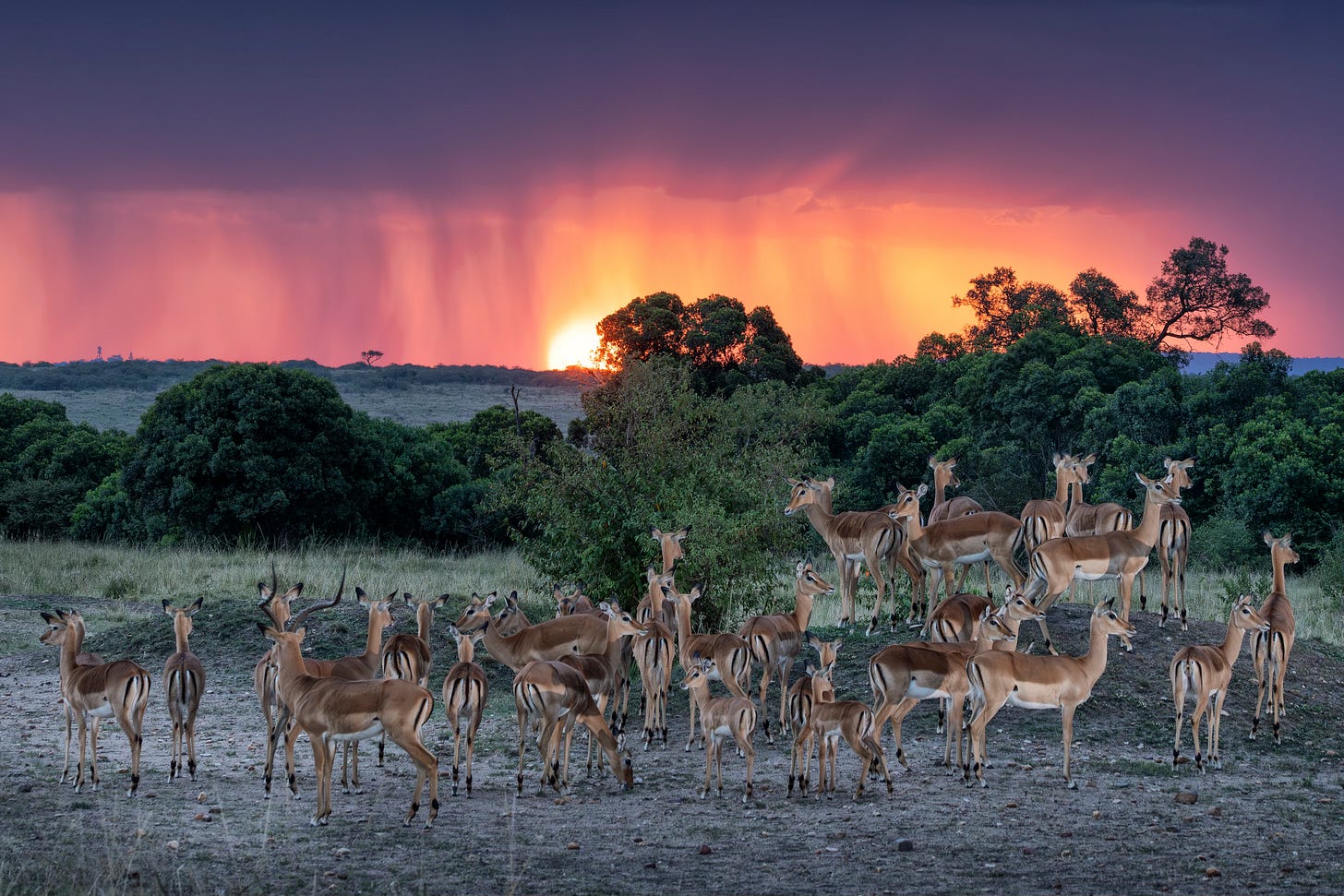

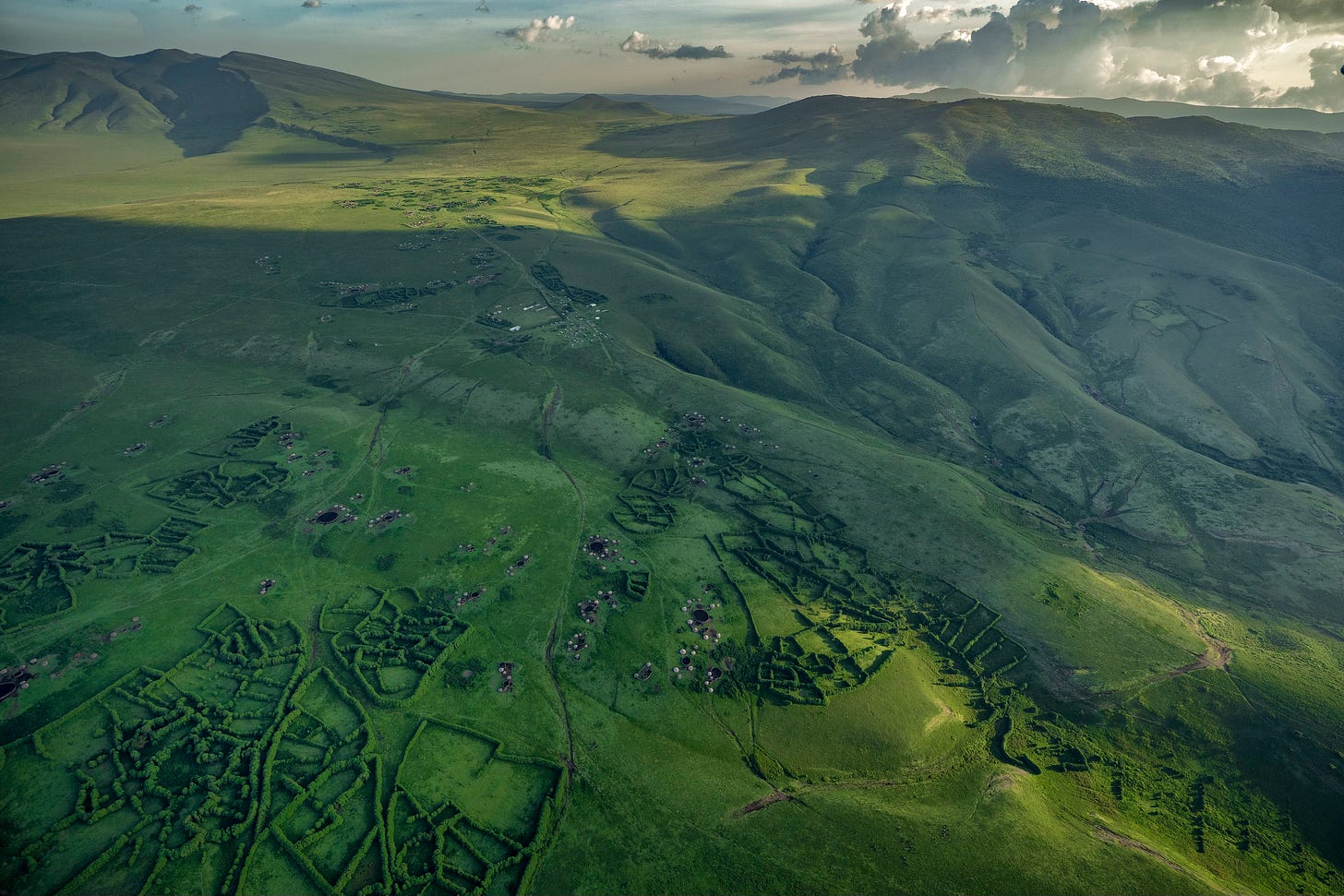
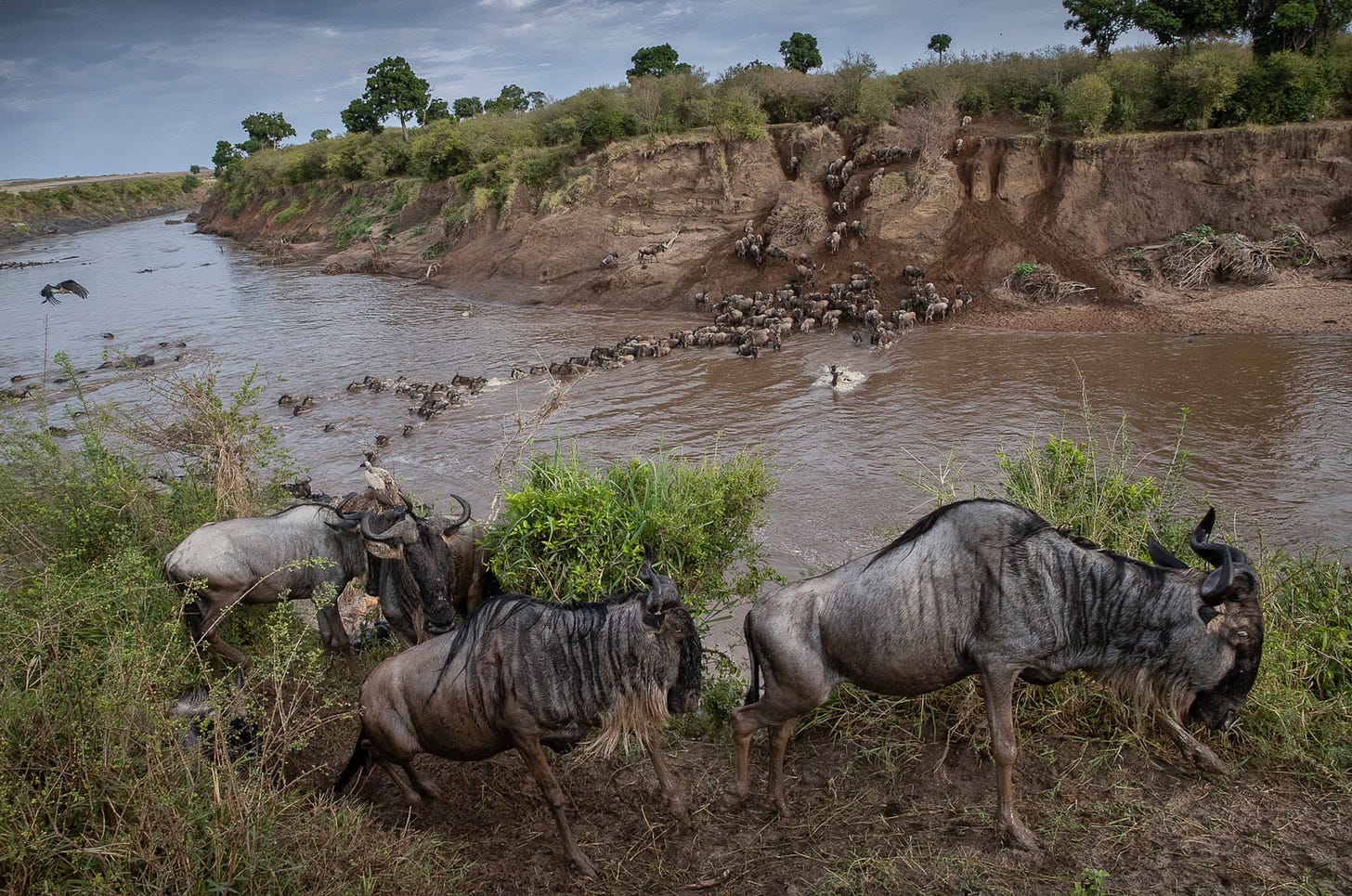

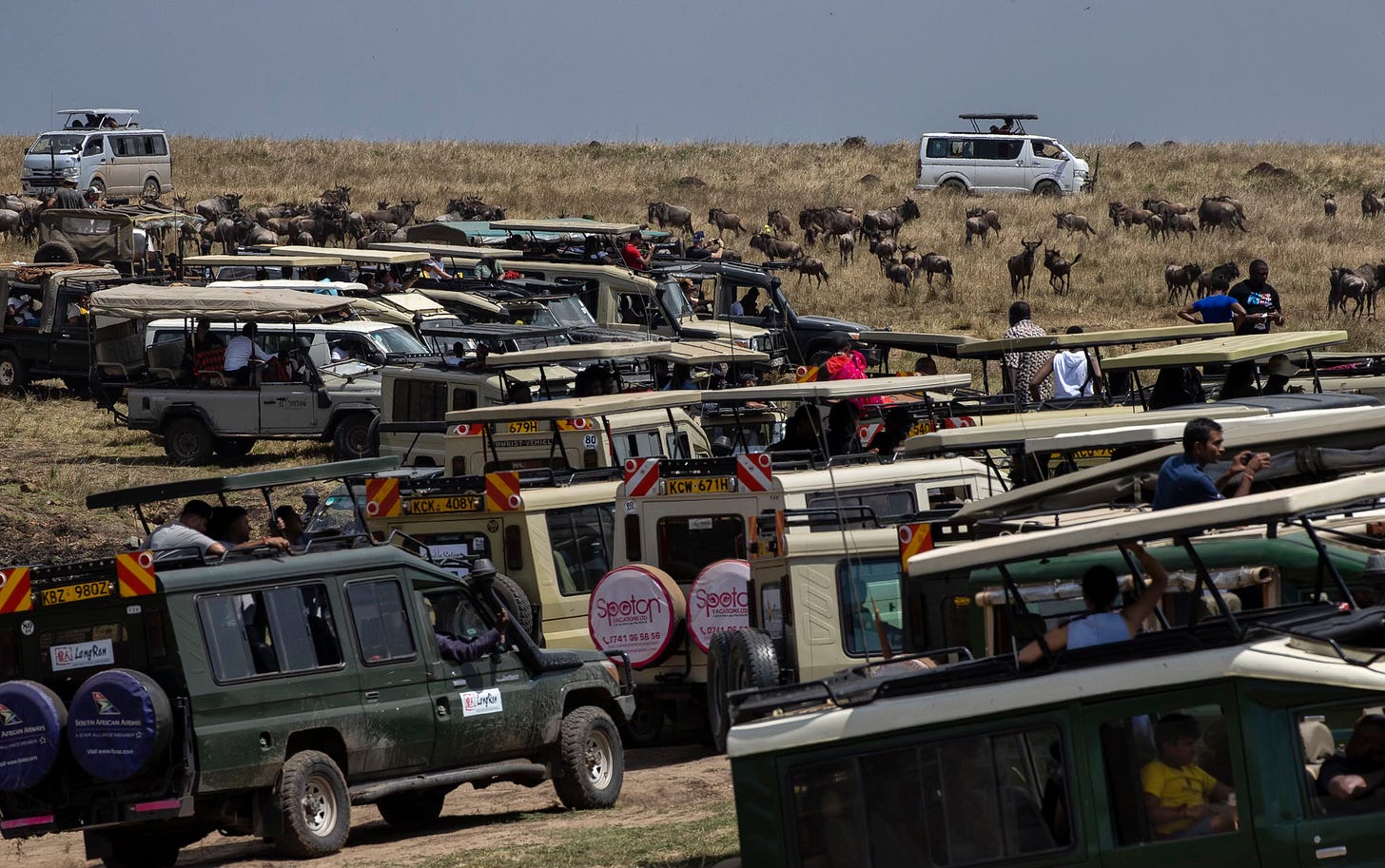


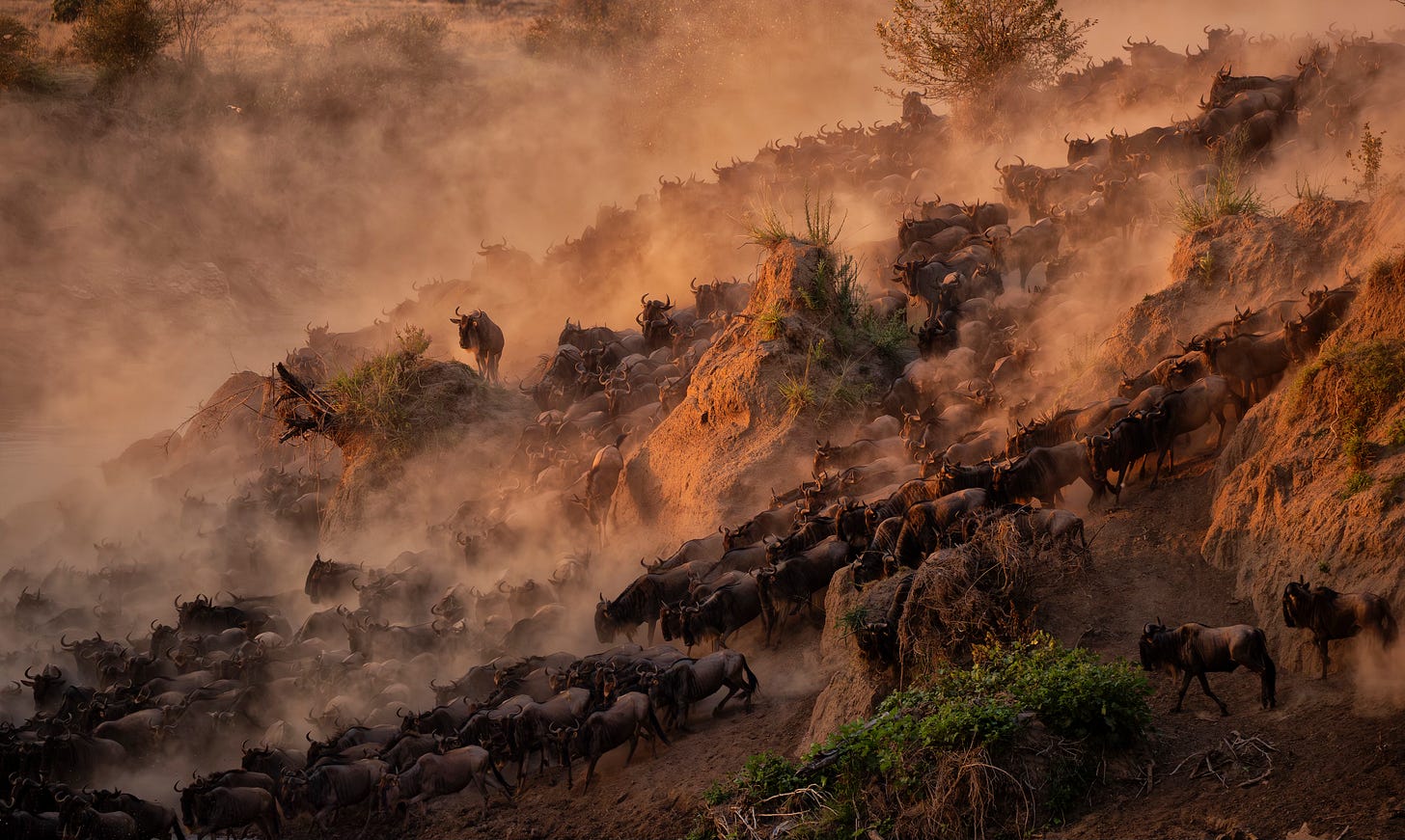
Beautiful, Charlie. Great read. Hell of a photo.
What?! The next chapter is the final chapter? Nooooo…..I don’t want this wonderful adventure of a book to end!